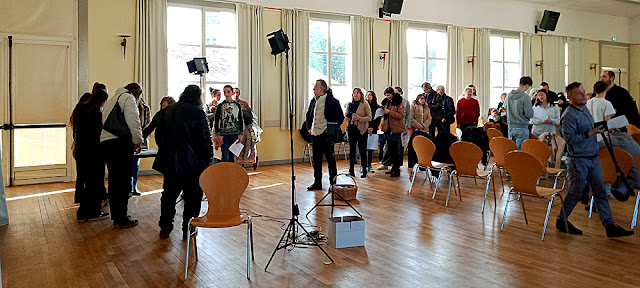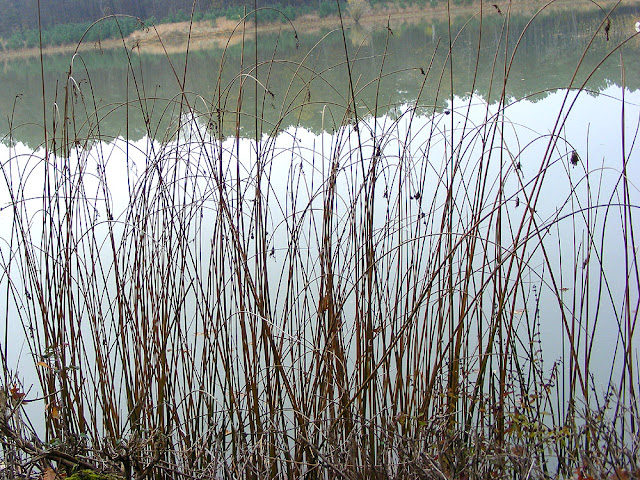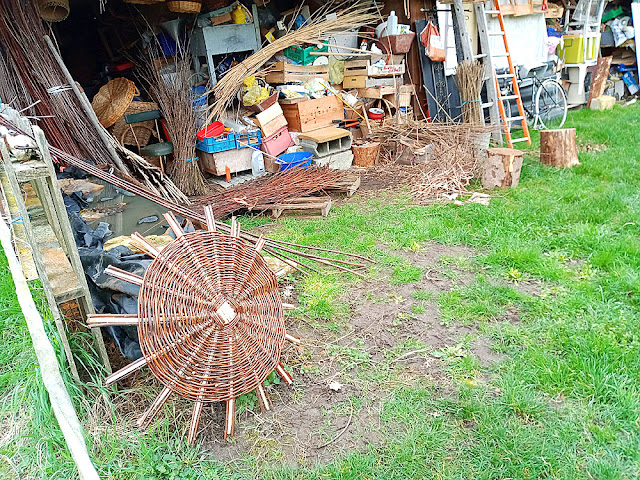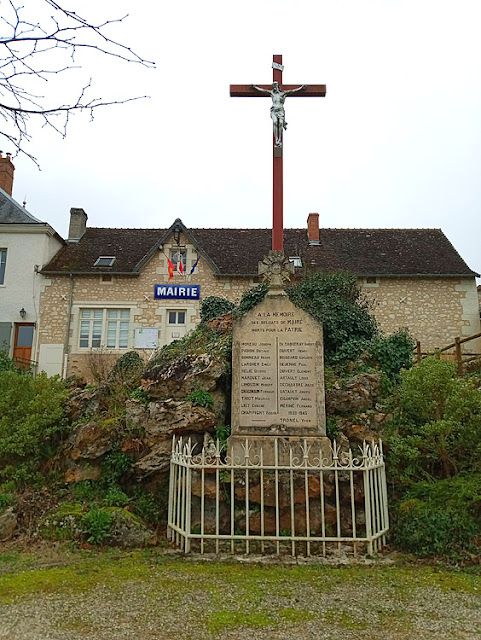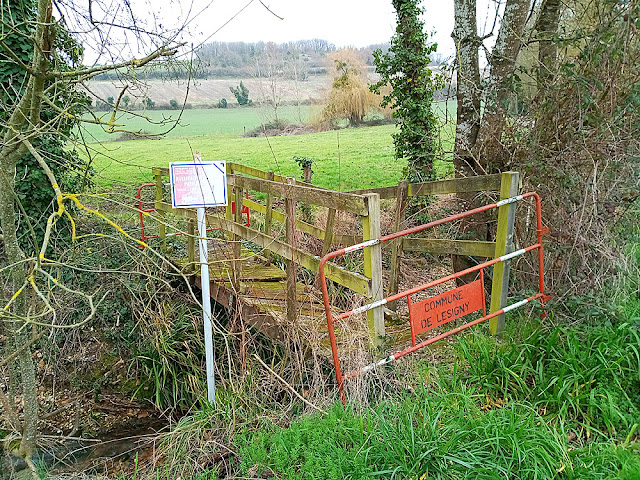Thursday 29 February 2024
Coucou!
Wednesday 28 February 2024
Colours Chosen
Tuesday 27 February 2024
A Wedding in Vouvray
Our friend Laetitia got married on Saturday. She asked if she could be driven in Claudette from the wedding celebration venue Domaine de la Roderie to the annexe of the Town Hall in Vouvray where the official wedding was taking place. After that we all went back to la Roderie for drinks and another, private, exchange of vows and the speeches. Finally there would have been a meal, but we didn't stay for that. Driving a Traction Avant at night in the rain is not an enjoyable experience, so we left at dusk to get Claudette back into her garage before dark.
Tables set for the reception.
The first photo of the bride was taken by me, as by the time she emerged at la Roderie the photographer had left for the town hall,
Laetitia seated in Claudette.
Wedding guests clustering around the entrance to the Auchan supermarket carpark, opposite the annexe to the Vouvray town hall where the wedding would take place. It looked like we were waiting to start a manif (street demonstration).
Claudette arriving at Vouvray town hall annex, driven by Simon and carrying Laetitia, her mum and her best friend.
The newlyweds and their parents (and nephew). At the end of the official ceremony the mayor chipped them for having just moved from Vouvray to Montlouis, the rival wine town on the opposite bank of the Loire!
The Mums have a word.
We were served mulled cider and hot chocolate under an awning at la Roderie while we waited for the bride and groom to arrive after a photo session in Vouvray.
The second ceremony, in the barn at la Roderie. Guests were given fleece blankets.
One got a good view of the 17th century barn roof construction.
Domaine de la Roderie https://www.laroderie.com/
Monday 26 February 2024
Digging out Stuff
The effect we're hoping to end up with is this. Our previous pierre apparent walls were done with lime and red sand. This time we're going to use white sand.
Saturday 24 February 2024
No Blog Post Today
Friday 23 February 2024
Oh! How it Rained
It rained most of yesterday morning and afternoon, and the rain was accompanied by gusty winds.
The weather forecast wasn't looking promising by mid morning with the wind warning uprated from 80km/h to 95km/h, and it certainly felt like that on the road from Preuilly to Châtellerault. There was some flooding and a lot of debris on the road, and when we came out if the hardware shop it was absolutely hammering it down.
These photos of the Claise were taken a couple of days ago. If anything, the river is higher now.
Thursday 22 February 2024
Casting for Les Bodin's
Les Bodin's is a comic double act created in 1994 and based at Descartes. Comedians, writers and directors Vincent Dubois and Jean-Christian Fraiscinet have created the characters of Maria Bodin, a cunning and manipulative old widowed farmer in her 80s, and her gormless son Christian.
Every July for the past 19 years they have put on a big outdoor show called 'les Bodin's, Grandeur Nature' on a local farm. It has become a cult and is already sold out for this year.
The duo perform live as the characters at festivals and charity events around the country, and every so often they make a film or a television show.
I've never seen them perform, but it is clear they are madly popular in the district (at least with an older crowd -- I don't think the under 40s are so enamoured). My guess is that if you like British comedies like Mrs Brown's Boys, you would like les Bodin's if you were French speaking. I would also observe that the French taste in comedy can be remarkably unsophisticated...
Anyway, great excitement in Preuilly when it was announced all over Facebook that les Bodin's would be coming to town and casting 600 extras for their next movie. Hundreds of people duly turned up at the salles des fetes to try out as villagers, cattle herder, goat farmer, receptionists, militant ecologists, police officers, acrobatic dancers, musicians, marching girls, accordionist, tie wearing public servants, little girl and a teenage boy. Our friend Mathieu didn't even have to audition. The production team approached him at work behind the bar of his restaurant, l'Image, and asked if he'd play himself in a bar scene.
So I guess we'll go and see the movie once it's released. There will most probably be a special pre-release showing in the salle des fetes.
Wednesday 21 February 2024
Renovation Update 2
In addition to working on the fireplace in the bedroom, I have done some further work on the stone wall in the salon. This is a dirty and dusty job, which involves removing layers of soot, grime and dust from the stone and cleaning the joints between them. Some of this appears to have been mud (I'm being polite) which either falls off in clumps or turns to brown dust. Most unappealing.
Tuesday 20 February 2024
What's the Rush?
Once upon a time there would have been a rush weaver in nearly every village, and the plant they used would have been abundant on the edges of rivers and étangs (dams) where the water was shallow and still. Now the plant, true bulrush Schoenoplectus lacustris, is sufficiently rare that if you have it growing on a site you can have it declared a Zone Naturelle d'Interet Ecologique, Floristique et Faunistique (ZNIEFF). It is easy to cultivate, but rush products went out of fashion and the skills to process the plant were lost. Nowadays it is making a comeback, but as an aquatic plant used in environments that need stabilising.
True Bulrush at the Etang du Louroux, a great purpose built pisciculture dam, hand dug in the Middle Ages, so this is a scene that has barely changed for eight hundred years.
In French bulrush is known as Jonc des chaisiers ('chairmakers' rush') because it was used to weave the seats of chairs. And it was used by coopers to bind barrels before the iron hoops were put on, hence it's alternative French name of Jonc des tonneliers. Up until the 1960s, rush harvesting was a quite lucrative side hustle for farmers with marshy land (particularly in the Marais Poitevin). These days though, 'rush' seats are made from twisted paper fibre or seagrass.
Rush matting on the floor, specially made in the 16th century style for the garderobe of Chateau of Azay le Rideau by an English rush weaver experienced in historical reproductions.
Some years ago curators at the Chateau of Azay le Rideau recreated Philippe Lesbahy's 16th century bedroom and included rush matting.
Taking their cue from a well known portrait of a royal mistress in the bath, hand made rush matting was commissioned from an English artisan who is one of the few remaining professional rushworkers in Western Europe. The painting shows the walls of the room the woman sits in as lined with rush matting. The chateau sadly does not have the original painting on display -- that's in Washington -- but it does have a 19th century version that you can get extremely close to and scrutinise for details.The actual braiding pattern for the matting is based on a fragment found at Hampton Court Palace.
Rush matting was a relatively cheap and easily available alternative to expensive carpets and tapestries. The purpose of all of these soft furnishings was to prevent cold radiating from the stone walls and to deaden sound in large echoing rooms. Housekeeping was easy -- dirt mostly just falls through, but it is a good idea to periodically mist with water to keep the rush in good condition and pleasantly aromatic.
True Bulrush in a ZNIEFF at Chambon.
Monday 19 February 2024
Creating A Stink in Normandy
Normandy is on everyone's social media at the moment, in the lead up to the 80 anniversary of the invasion. So I've had several conversations recently about Normandy and what one can do there. One of the things one can do is seek out Pont l'Eveque cheese. Below is a repost from ten years ago about the stinky Norman cheese.
****************************************
France is famous for its cheese, and quite a few French cheeses are distinctly aromatic. One of the stinkiest comes from the area between Deauville and Lisieux in Lower Normandy. Simon loves to tell people the story of us spending Christmas in the area and taking a block of the local Pont l'Eveque cheese home on Eurostar.The other day he announced that the fridge smelled, as if there was stinky cheese in there, but he couldn't see the source of the aroma and was mystified. Eventually I remembered that I had bought a Petit Pont l'Eveque some days earlier. It was unopened, and hidden under something else, but after a few days in the fridge had completely stunk it out. We happily unwrapped it and ate it and the fridge problem disappeared. A clear win-win.
There is a very fine line between good stinky and bad stinky with cheese. Once the lactic aromas go over a certain level or develop in a certain way the cheese turns from being a delicious treat to something disgusting that turns the stomach. But the cut-off point between delicious and disgusting is different depending on where you were raised and what foods you have been exposed to.
The French anthropologist Claude Lévi-Strauss had quite a lot to say about this particular aspect of our approach to food and how our attitudes are culturally acquired. He points out that these distinctions are entirely learnt, and not instinctive or innate as one might think. He illustrates his point at one stage by relating how, in the days after D-Day, American troops would occasionally encounter fairly whiffy dairies in the Norman countryside. To the unsophisticated Americans, who had never been exposed to anything more challenging than processed cheddar, they assumed the dairies were full of dead bodies, and burnt them to the ground. They were revolted and wanted to eliminate the smell.
Saturday 17 February 2024
Beer Tales
Friday 16 February 2024
Walking From Etableau
On Monday 12 February we joined the Phoenix en Claise walking group on a 5.5 kilometre circuit from Etableau, up to the Chateau de la Vienne, across to Courvault then back to Etableau on the voie verte (greenway). It took us an hour and a half.
The wicker (Fr. osier) weaver's workshop in Etableau.
The walking group approaching the 19th century Chateau de la Vienne (privately owned and not open to the public).
Snowdrops Galanthus sp are out everywhere in the Claise Valley at the moment. It's hard to know if these are native or naturalised.
The gable end of this barn in Courvault is constructed mainly of flint.
The hamlet of Courvault.
Thursday 15 February 2024
Renovation Update
By Friday most of the insulation and much of the plasterboard had been installed so it was time for Stan the electrician to do his first fit. Over the weekend I attacked the fireplace in the bedroom, then worked continued on the remainder of the walls and the ceilings.
Wednesday 14 February 2024
Walking From Maire
On Monday 5 February we joined the Phoenix en Claise walking group for a 6 kilometre circuit from the small pretty village of Mairé, overlooking the Creuse River. This is always a challenging walk, as it includes the most elevation change of any of our local walks. We had to struggle up a further 145 metres from our start point -- nowhere else has this much climbing! And it was very muddy in places. We had to stop twice to lever mud off our boots with sticks we found at the side of the track. The walk took one and three-quarter hours, including fording streams, climbing hills, taking photographs and shedding mud build ups.
Mairé town hall and war memorial.
The main street of Mairé and looking down into the Creuse Valley.
Palms in a front garden in the village (I assume Windmill Palm Trachycarpus fortunei).
A view from the heights.
Fording a stream...
...because the foot bridge looks like this...
Abandoned agricultural machine.





















